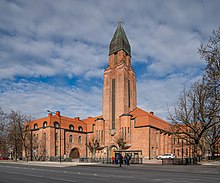
Berlin Cathedral, also known as the Evangelical Supreme Parish and Collegiate Church, is a monumental German Protestant church and dynastic tomb on the Museum Island in central Berlin. Having its origins as a castle chapel for the Berlin Palace, several structures have served to house the church since the 15th century. The present collegiate church was built from 1894 to 1905 by order of Emperor William II according to plans by Julius Raschdorff in Renaissance and Baroque Revival styles. The listed building is the largest Protestant church in Germany and one of the most important dynastic tombs in Europe. In addition to church services, the cathedral is used for state ceremonies, concerts and other events.

St. Mary's Church, or formally the Basilica of the Assumption of the Blessed Virgin Mary, is a Brick Gothic Catholic church located in central Gdańsk, Poland. With its volume between 185,000 m3 and 190,000 m3 it is currently one of the two or three largest brick churches in the world. Only San Petronio Basilica in Bologna, comprising 258,000 m3 is larger, Munich Frauenkirche and Ulm Minster also comprise 185,000 to 190,000 m3.

Georg Lurich was an Estonian Greco-Roman wrestler and strongman of the early 20th century. Lurich was also the trainer of Estonian wrestlers and weightlifters Georg Hackenschmidt and Aleksander Aberg.

Gloria Dei Church, known locally as Old Swedes', is a historic church located in the Southwark neighborhood of Philadelphia, Pennsylvania, at 929 South Water Street, bounded by Christian Street on the north, South Christopher Columbus Boulevard on the east, and Washington Avenue on the south. It was built between 1698 and 1700, making it the oldest church in Pennsylvania and second oldest Swedish church in the United States after Holy Trinity Church in Wilmington, Delaware.

St. John's Evangelical Lutheran Church is a Gothic Revival-styled church built in 1889 in Milwaukee, Wisconsin by a congregation with German roots. In 1992, the church and associated buildings were listed on the National Register of Historic Places. It is also designated a Milwaukee Landmark.

St. Peter's Evangelical Lutheran Church, or Iglesia Luterana San Pedro, is a historic church complex located in the Walker's Point neighborhood of Milwaukee, Wisconsin. Its buildings are listed on the National Register of Historic Places.
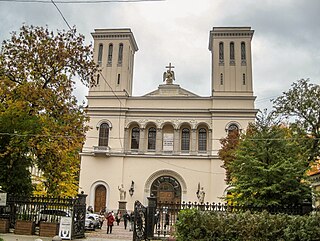
The Lutheran Church of Saint Peter and Saint Paul is a Lutheran church in the center of St. Petersburg on Nevsky Prospekt. Divine services are held regularly on Sundays from 10:30 in German and Russian. The rector of the parish, the Rev. Michael Schwarzkopf, is also the head of the North-West Probate of the Evangelical Lutheran Church of the European Part of Russia. Also in the church building is the office of the Archbishop of the Union of Evangelical Lutheran Church in Russia, Ukraine, Kazakhstan and Central Asia.

The Parochialkirche is a Reformed church in the Klosterviertel neighbourhood of the Mitte borough in Berlin. The church, now a listed building, was built between 1695 and 1703. It is the oldest church in Berlin built as a Protestant place of worship. The church is now used and owned by the congregation of St. Mary's and St. Peter's, the merger of the parishes in the historical city center concluded on 23 September 2005. The congregation forms part of the Evangelical Church Berlin-Brandenburg-Silesian Upper Lusatia, a Protestant regional church body comprising Lutheran, Reformed and united Protestant congregations.

Saint John's Lutheran Church is an active church building located at 121 South Locust Street in the city of Adrian in Lenawee County, Michigan. It was designated as a Michigan State Historic State on February 23, 1981 and shortly after listed on the National Register of Historic Places on December 27, 1984. The Lutheran congregation moved to a new home in 2007, and the church building now houses the Reformed Baptist Church of Lenawee.

The Evangelical Lutheran Church of Ingria is a Lutheran church of the Scandinavian tradition in Russia. It is the second largest Lutheran church in Russia, with 90 congregations and 15,000 members, and is active mostly in Ingria and Karelia.
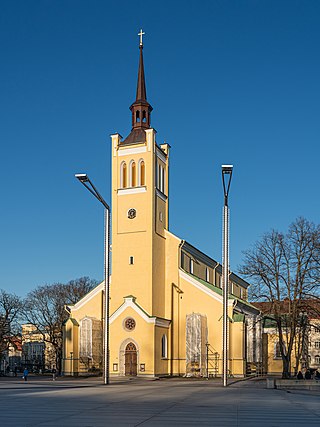
St. John's Church is a large Lutheran parish church in Tallinn, Estonia. It is dedicated to Saint John the Evangelist, a disciple of Jesus Christ and author of the fourth Christian Gospel. Construction began in 1862, and the church was opened in 1867.

St. John's Church, Tartu is a Brick Gothic Lutheran church, one of the landmarks of the city of Tartu, Estonia. It is dedicated to John the Baptist.

The Lutheran Church of Saint Michael is an Evangelical Lutheran church in St. Petersburg. Since 1992, it has been an active parish of the Church of Ingria.

Hugo Bernhard Rahamägi was a prominent Estonian prelate and politician who served as Minister for Education in the Estonian government between 1924 and 1925 and later as Bishop of Tallinn and Primate of the Estonian Evangelical Lutheran Church from 1934 till 1939.
Alfred Tooming was an Estonian prelate who served as the Archbishop of Tallinn and Primate of the Estonian Evangelical Lutheran Church between 1967 and 1977.
Edgar Hark was an Estonian prelate who was the Archbishop of Tallinn and Primate of the Estonian Evangelical Lutheran Church between 1978 and 1986.

Joel Luhamets is an Estonian Lutheran prelate who is the current bishop of the Southern Region whose seat is in Tartu, Estonia.
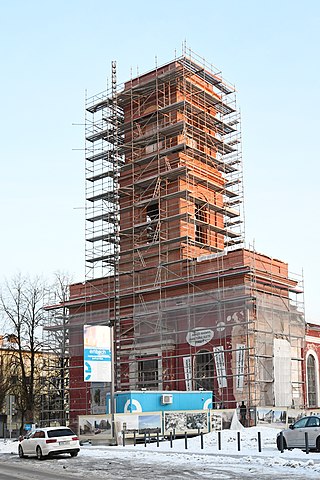
St Mary's Church is a 19th century church of the Estonian Evangelical Lutheran Church located in Tartu, Estonia.
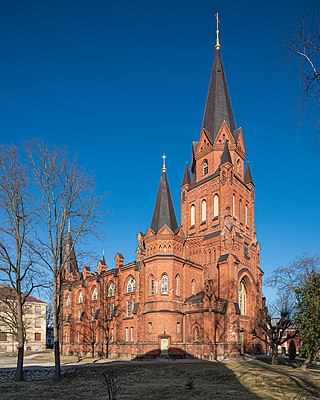
St Peter's Church is a 19th-century church of the Estonian Evangelical Lutheran Church located in Tartu, Estonia.

Dormition Cathedral, formally known as The Cathedral of the Dormition of Our Lady or simply Uspenski Cathedral is a cathedral church of the Estonian Apostolic Orthodox Church in Tartu, Estonia.
